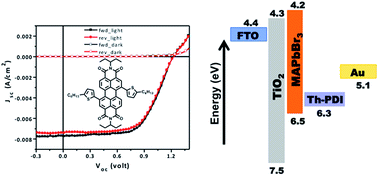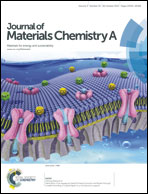Thiophene-modified perylenediimide as hole transporting material in hybrid lead bromide perovskite solar cells†
Abstract
A small molecule based on N,N′-dialkyl perylenediimide (PDI) as core derivatized with thiophene moieties (Th-PDI) was synthesized. Its HOMO (highest occupied molecular orbital) level was measured to be between 5.7 and 6.3 eV vs. local vacuum level depending on doping and measurement method. Th-PDI was successfully applied as hole-transporting material (HTM) in CH3NH3PbBr3 hybrid perovskite solar cells. Three different cell architectures, each with a different mode of operation, were tested: (1) using a mesoporous (mp) TiO2 substrate; (2) mp-Al2O3 substrate; (3) planar dense TiO2 substrate. The first gave the best overall efficiency of 5.6% while the mp-Al2O3 gave higher open-circuit photovoltage (VOC) but lower efficiency (2.2%). The cells exhibited good reproducibility with very little J–V hysteresis (the mp-Al2O3 showed a more appreciable hysteresis of individual photovoltaic parameters but little dependence of efficiency on scan direction). Storage of unencapsulated cells in 25–30% relative humidity demonstrated fairly good stability with <20% efficiency drop after 37 days. While further optimization of each layer in the device is needed, the synthetically-simple new molecule shows promise as an inexpensive and readily-doped HTM for use in photovoltaic cells where a deep HOMO level is needed.


 Please wait while we load your content...
Please wait while we load your content...